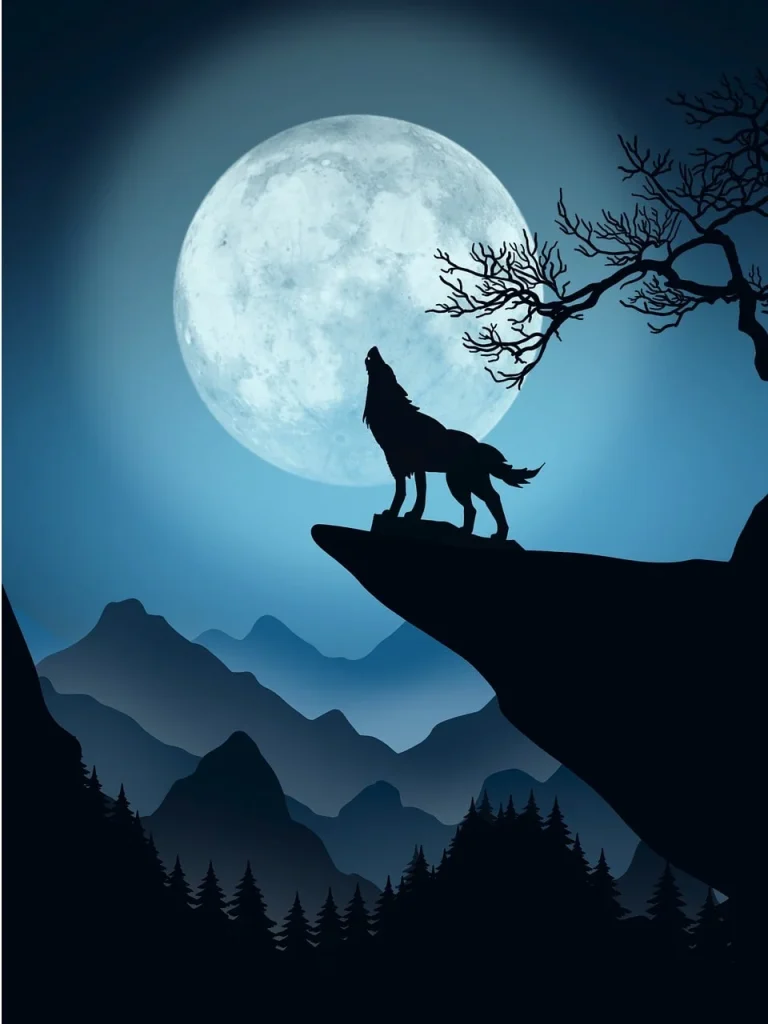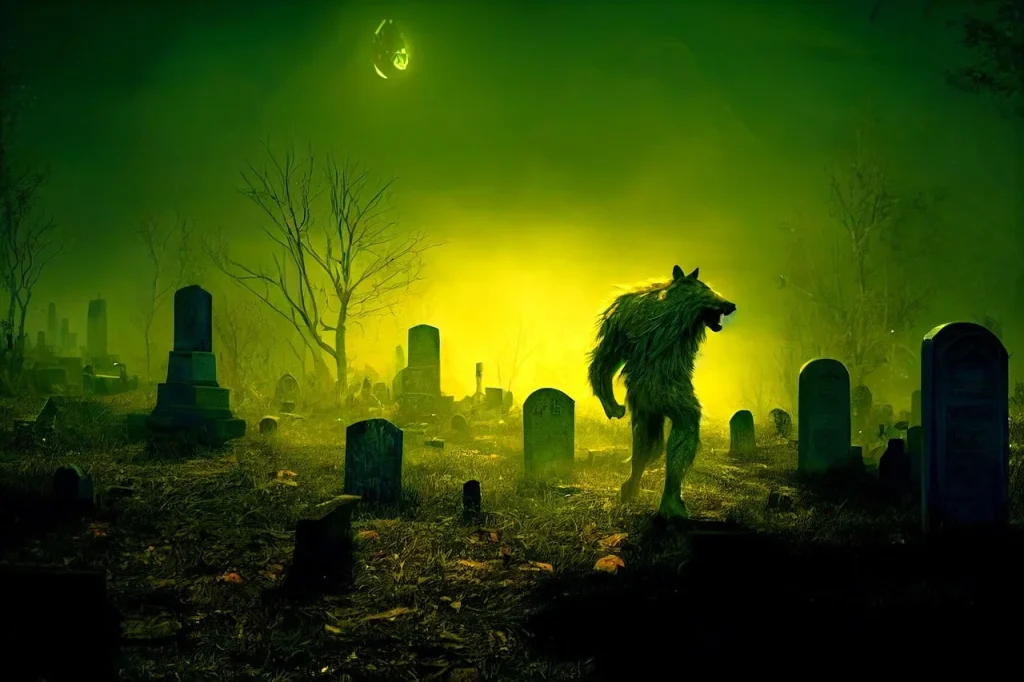What is it about werewolves that both terrifies and fascinates us? Is it their wild nature, or the duality of man and beast?
This article promises to take you on a journey through the shadowy realm of werewolves with some interesting facts that explore their folklore, transformations, and the spell they’ve cast over our collective imagination.
From their legendary vulnerabilities to their surprising appearances in historical accounts, get ready to meet the werewolf beyond the myths.
The werewolf is neither man nor wolf, but a satanic creature with the worst qualities of both.
Warner Oland
Werewolf Facts
Prepare to unleash the beast within with these facts! Dive into the details and read carefully—there’s a quiz at the end to test if you truly are a werewolf expert.
- Many cultures believed that wearing a belt made of wolf skin could transform a human into a lycanthrope.
- During the witch trials in Europe, accused witches often also faced accusations of lycanthropy, intertwining the myths of witches and these creatures.
- The transformation from human to beast was often associated with painful physical contortions and bone reconfiguration, reflecting the agony of metamorphosis.
- In some legends, the sight of a corpse could trigger someone to become a creature, especially if the deceased had been a lycanthrope.
- The term “lycanthropy” is clinically used in psychiatry to describe a delusion in which a person believes they can transform into a wolf, showcasing the deep psychological roots of the legend.
- The full moon’s role in transformations isn’t universal—some stories cite particular phases of the moon or even complete disregard for lunar cycles.
- Medieval Europe treated lycanthropy as a serious and punishable offense, often met with execution or severe forms of exorcism.
- In some Native American traditions, these creatures are seen as guardians that protect the community, contrasting with the European portrayal of malevolent beings.
- The rare disease hypertrichosis, which causes excessive hair growth, has historically been linked with real-life accounts of werewolves.
- In the 16th century, one of the most famous cases was that of Peter Stubbe in Bedburg, Germany, who confessed under torture to being a shape-shifter and cannibal.
- The silver bullet as a method of killing werewolves didn’t appear in popular folklore until the 19th century; earlier texts recommended methods like wolfsbane and consecrated weapons.
- French tales often featured the loup-garou, a version of the werewolf, implying that the person could voluntarily shape-shift, differing from the involuntary transformation in other cultures.
- In some stories, if a lycanthrope bites a human, the bitten person also becomes a beast, a trait that parallels modern vampire legends.

- Unlike most supernatural creatures, lycanthropes are often portrayed as retaining human eyes in their beast form, a detail that emphasizes their trapped human soul.
- The werewolf trial records in Estonia are some of the most numerous in Europe, highlighting a regional peak in beliefs regarding these shape-shifters.
- Argentinian folklore contains the tale of the Lobizón, believed to be the seventh son turned into a creature, leading to a law that the President adopts seventh sons as godchildren to prevent their transformation.
- Early Hollywood significantly shaped the modern image of these creatures, especially through the 1941 movie “The Wolf Man,” where many now-common elements were first introduced.
- In some folklore, only those born on Christmas Eve or a new moon could become true lycanthropes, highlighting specific “cursed” birthdates.
- The transformation often requires the presence of an enchanted or cursed item, such as a pelt or a charm, emphasizing the role of magical objects in folklore.
- Some legends claim that these creatures can be cured through exhausting their energy until they revert to human form at sunrise, often requiring the intervention of a brave or pure-hearted individual.
- In the Harry Potter series, the character Remus Lupin is used to explore themes of stigma and secrecy, illustrating how myths can be adapted to discuss modern societal issues.
- Recent scientific discussions about genetic memory and animalistic instincts draw parallels to the myth, suggesting a deep-rooted, innate fear of the beast within.
- In the Balkans, it was believed that eating a sheep killed by a wolf could turn a person into a lycanthrope.
- Historically, outbreaks of rabies in Europe may have contributed to the werewolf hysteria, as victims displayed aggressive behavior and fear of water, similar to reported creature behavior.
- Geometric symbols and protective amulets were often used in Eastern Europe to protect against these beings, indicating a blend of paganism and Christianity in protective rituals.
- Victorian literature often depicted werewolves as tragic figures, capable of love and humanity, thereby challenging their monstrous portrayal in earlier folklore.
- In some tales, these creatures could only be killed by being decapitated with a shovel, a method specific to certain Slavic regions.
- Research into European folklore has uncovered cases where individuals claimed werewolf abilities to explain acts of rebellion against oppressive authorities.

- The werewolf has appeared in legal documents from as far back as ancient Greece, where a man was charged for damaging crops while claiming to be a wolf.
- In modern pop culture, werewolves often symbolize unrestrained nature and freedom, contrasting with their more negative medieval interpretations.
- The idea that lycanthropes are immune to diseases other than those caused by silver is a modern invention, possibly reflecting contemporary fears of contagion and disease.
- During the 18th and 19th centuries, reported werewolf sightings were often linked to areas undergoing social and economic turmoil, suggesting a metaphorical rather than literal interpretation of the myth.
- Werewolf legends are particularly prevalent in areas with large wolf populations, suggesting a direct correlation between the animal’s presence and the myth’s popularity.
- Modern psychological analyses interpret the transformation myth as a representation of puberty or other major life changes, emphasizing the fear and confusion associated with such transitions.
- Unlike many other supernatural creatures, werewolves have been integrated into various religious beliefs, often used as examples of divine punishment or moral testing.
- It was once believed that you could become a werewolf by drinking water collected in a footprint left by the animal.
- Some modern therapies use the werewolf metaphor to help people deal with anger management issues, reflecting the enduring psychological impact of the legend.
- Contemporary fantasy literature often pairs werewolves with vampires, despite their origins in different cultural myths, highlighting a modern synthesis of supernatural beings.

- The transformation is sometimes depicted as being triggered by environmental stress or emotional upheaval, linking it to human psychological responses.
- Online communities have formed around the werewolf myth, with members sometimes believing in or role-playing as these creatures, a phenomenon known as “therianthropy.”
- Forensic investigations during the werewolf trials sometimes involved checking for a “wolf strap,” a supposed magical item that enabled the transformation.
- In digital media, werewolves often appear as characters that can be controlled or transformed at will, illustrating their shift from uncontrollable beasts to sympathetic antiheroes.
- Some regions differentiated between good and evil werewolves, where “good” ones protected communities from bandits or other threats.
- Cultural depictions of werewolves have evolved from solitary predators to complex characters capable of forming packs and communities, reflecting changes in how humans view society and individuality.
- The concept of a werewolf has been used metaphorically in political and social discourse to discuss the idea of the “other” within society, often highlighting themes of xenophobia and exclusion.
- In psychological terms, lycanthropy serves as a powerful archetype for exploring the shadow self, the part of the human psyche that an individual is often unaware of or chooses to ignore.
- Art and literature over the centuries have portrayed werewolves in myriad forms, from horror and tragedy to romance and satire, demonstrating their versatile role in human storytelling.
- In earlier folklore, it was believed that making a pact with the devil was a prerequisite for transforming into a werewolf, often during a ritualistic ceremony.
- Genetic studies and folklore have both been used in attempts to trace the historical origins of werewolf myths, linking them to regions with ancient traditions of shape-shifting.
- During periods of famine or hardship, werewolf sightings and accusations often increased, suggesting that the myth may have been a way to explain or cope with societal stresses and unexplained violence.
Werewolf Myths

With the facts in hand, we now turn our attention to the myths. Let’s clear up the misconceptions and separate fact from folklore as we continue.
- Werewolves Transform Only on Full Moons
It is often believed that they transform solely during full moons. However, in many folklore and stories, transformations can be triggered by various emotions or events, not strictly limited to the lunar cycle. - Werewolves are Invulnerable Except to Silver Bullets
The notion that they can only be harmed by silver bullets is a modern invention. Historically, they were considered susceptible to normal weapons, just like any other creature. - Werewolves Can Only Be Men
There is a common misconception that only men can become werewolves. In folklore from different cultures, it is shown that both men and women are equally likely to turn into werewolves. - Werewolves Are Always Violent
While depicted as ferocious beasts in many tales, not all legends portray werewolves as inherently violent. Some narratives suggest that werewolves can control their urges and retain human consciousness. - Becoming a Werewolf is Only Through a Bite
It is widely believed that their traits are passed down through bites. However, other myths suggest various methods, such as wearing wolf skin or drinking water from a wolf’s paw print.
No products found.
Werewolf Quotes

Let’s continue with the words of authors and folklorists and see how they’ve captured the primal fear and raw power of the werewolf. You can always share more quotes in the comments, and I will add them to the list.
Everyone’s a moon, and has a dark side which he never shows to anybody.
Mark Twain
Although not specifically about werewolves, Mark Twain’s quote metaphorically relates to the hidden, darker nature of werewolves.
A werewolf, a vampire, and a ghost walk into a bar. But no one saw them!
Anonymous
This humorous take plays with the idea of supernatural beings blending into everyday situations unnoticed.
No beast so fierce but knows some touch of pity. But I know none, and therefore am no beast.
William Shakespeare
From “Richard III,” this line by Shakespeare, though not directly about werewolves, resonates with their often portrayed lack of mercy.
Werewolves are here to stay.
Kelley Armstrong
Kelley Armstrong, a prolific author of paranormal fiction, confidently states the enduring appeal and presence of werewolves in modern storytelling.
I’m much more afraid of human beings than I am of werewolves.
Donna Tartt
Donna Tartt provides an insightful commentary on human nature, suggesting that real people can be more frightening than mythical creatures like werewolves.
Werewolf FAQ

As we draw closer to the end, the next section has frequently asked questions about werewolves. Be sure to read carefully, as this will be your last chance to prepare before the upcoming quiz.
- Can werewolves kill vampires?
Yes, in many myths and stories, they have the strength and capability to kill vampires. This rivalry is a popular theme in folklore and fiction, where the supernatural powers of each often clash dramatically. - Are werewolves real?
They are not real; they are mythical creatures that have been part of folklore and storytelling across various cultures. The idea of humans transforming into wolves is a symbolic and fascinating concept, but it has no basis in scientific reality. - Can werewolves eat chocolate?
If they were real and similar to their wolf counterparts, chocolate would be harmful to them just as it is to dogs. In stories, however, their human side might allow them to enjoy chocolate without harm — it really depends on the rules of the fictional universe! - Are werewolves immortal?
They are not typically considered immortal. In most tales, they live as long as humans, with their lifespan unaffected by their ability to transform. They can be killed by usual means unless specific lore states otherwise. - Can werewolves swim?
Yes, they can swim. In their wolf form, they retain the abilities of a normal wolf, which include swimming. Their strength and endurance might even enhance their ability to handle water better than an average wolf.
No products found.
Werewolf Quiz

Welcome to the Ultimate Werewolf Trivia! Sharpen your claws and prepare to howl at the moon. But beware, if you miss every question, you might just find yourself turning into a werewolf at the next full moon!
Conclusion
In conclusion, they are not just creatures of horror stories; they are symbols of transformation and untamed nature. Exploring the lore surrounding werewolves allows us to understand the fears and fascination of different cultures with the wild and unknown.
Whether seen as monsters or misunderstood beings, they remind us of the thin line between man and beast. Till next time, stay curious and explore more. Cheers.


